If you're new here, you may want to subscribe to my RSS feed. Thanks for visiting!
Author of Be Ready for Anything and Bloom Where You’re Planted online course
It’s apple season! This is without a doubt one of my favorite times of the year. I love it when the house is fragrant with apples and cinnamon. A visit to a you-pick orchard or farm stand is a great way to spend a fall afternoon if you don’t happen to have an apple tree in your backyard. (You can find a local orchard or market HERE.)
Apple trivia: Apples are a member of the rose family. They have been cultivated throughout Europe since the Stone Age. Many refer to the forbidden fruit in the Garden of Eden in the Bible as an apple, and the fruit has figured into legends and folklore for centuries. Some examples are the fall of Troy, the marriage of Atlanta, Celtic mythology, the story of William Tell, and the story of Johnny Appleseed. There are 7500 recognized varieties of apples and the average American consumes 45 pounds of apples per year.
Nutritional benefits
The old adage goes, “An apple a day keeps the doctor away.” Here are a few reasons why this is true!
- One medium apple (about 3″ in diameter) contains about 95 calories, no fat, 25 grams of carbohydrates, and more than 4 grams of fiber.
- The phytonutrients in apples can positively affect insulin production to help regulate blood sugar.
- The consumption of apples can have a positive influence on the bacterial balance of the digestive tract.
- Much of the apple’s nutrients can be found in the skin, particularly beneficial polyphenols such as quercetin.
- Apples contain substantial amounts of Vitamin C, the B vitamins, and potassium.
- Regular consumption of apples has been proven to reduce the risk of cancer, diabetes, heart disease, Parkinson’s disease, and Alzheimer’s.
Using Fresh Apples
Always be sure to remove the pesticides and residues from apples. Even organic orchards allow the application of an antibiotic spray. Click HERE to learn how to clean your fruit.
Select firm, unbruised fruit and store it at 35-40 degrees Fahrenheit for the longest shelf life.
Apples with all-natural peanut butter or sharp cheddar cheese make a healthy nutritious snack.
A favorite way to enjoy fresh apples in our house is in an apple crisp.
Apple Crisp
Filling
- 8-10 ripe apples, cored and diced (peeling is optional)
- 1/2 cup of white sugar
- 1/2 cup of brown sugar
- 1/4 cup of lemon juice
- 1 tbsp of cinnamon
- 1/4 tsp of clove powder
Topping
- 1 cup of flour
- 1 tbsp of cinnamon
- 1/4 cup of water
- 1 cup of quick-cooking oats
- 1/2 cup of brown sugar (another one)
- 1/2 teaspoon baking powder
- 1/2 teaspoon baking soda
- 1 stick of butter, cut into little pieces
- a dash of salt
Directions
- In a rectangular glass baking dish, toss together all filling ingredients until the apple pieces are well coated.
- In a bowl, mix together all dry ingredients with a fork until combined.
- Stir in water then, with your hands, knead in butter, squeezing together the dough until it is a dry crumbly batter.
- Sprinkle the batter on top of the filling.
- Bake at 375, uncovered, for 55 minutes.
- Serve hot, topped with vanilla ice cream.
Preserving Apples
Freezing
Apples can be frozen with very little prep work. You can actually freeze whole washed apples on a cookie sheet, then move them to a large freezer bag for storage. A better option if space is an issue in your freezer is to core and slice the apples into your preferred sizes. Freeze them in a single layer on a cookie sheet, then move them to a freezer bag. Finally, you can freeze apple slices after tossing them in sugar. When you thaw them out, the sugar and juice from the apples will combine to make a syrup, making an almost instant apple pie filling.
Drying
Dried apples are a favorite lunchbox treat. Cut the apples into 1/8 inch thick slices. Place in a single layer on the rack of the dehydrator and dry on low for approximately 20 hours. You can also dry them in the oven. Toss the slices in lemon juice, white sugar and cinnamon and place them on foil lined cookie sheets. Set your oven for 200 degrees and dry the apple slices for 4-6 hours, or until crisp. In theory, these would be great lunch box treats, but unless you hide them, they won’t last that long!
Canning
Apples are the perfect fruit for canning. You can make apple jam, apple butter, apple sauce (this simple blender recipe is perfect for baby-food – only 2 ingredients!), or try one of the great recipes below. Hit the orchard and spend a Saturday making your house smell heavenly!
We came home with just over 40 pounds of apples on Friday. I soaked them to clean them, and then Saturday morning I was up early, chopping apples 20 pounds at a time at my little chopping station. I pulled a barstool up to the counter and got busy. I’m not usually a kitchen gadget person, but when processing this many apples, one small tool that I find invaluable is the little $5 apple corer that you see in the picture. It takes more pressure than cutting the apples up with a knife, but the work goes far faster and you are less likely to cut yourself.
Apple Filling
I like to make apple filling that isn’t thickened. If I want to make it thick later, all I need to do is add a bit of flour and butter.
This time around, I did things a bit differently. I opted to only add a splash of water and a splash of lemon juice instead of making a syrup. This makes the resulting filling excellent for items that you don’t want to be too runny, such as apple crisps or turnovers. It does settle during the canning process, so expect there to be some additional headspace at the top when you take the jars out.
Ingredients
- 20 pounds of apples
- 2 cups of white sugar
- 1/2 cup of lemon juice
- 2 tbsp of cinnamon powder
- 1 tsp of clove powder
Directions
- Clean apples carefully to remove pesticides.
- Cut the apples into the desired form. I prefer a chunky diced apple, but some people prefer slices.
- In a large bowl or stockpot, toss the apples with lemon juice, sugar, clove powder, and cinnamon.
- Allow the apples to sit for about 15 minutes, then ladle them into sanitized quart jars.
- Add 1/4 cup of water to each jar, then lid them.
- Process in a water bath canner for 35 minutes, adjusting for altitude.
- Alternatively, process them in a pressure canner at 5 pounds for 13 minutes, also adjusting for altitude.
Spiced Apple Sauce
I leave the peel on mine for extra nutrition but this is optional – once I use the blender to puree the apples you can’t tell that the peel was left on. This decadent fragrant apple sauce will also leave you with a few quarts of apple and spice liquid that can be canned and used as a hot beverage on a winter day.
Ingredients
- 20 pounds of apples, cored and chopped
- 1 cup of pure unsweetened lemon juice (give or take a little)
- water as needed
- 1/2 cup of cinnamon
- 1/8 cup of powdered ginger
- 2 tbsp allspice
- 1 tbsp powdered clove
Directions
- Place your chopped apples and lemon juice into a large stockpot (or two). After the apples are in the pot, add the water until it is at about an inch below the top of the fruit.
- Stir in the spices and bring to a boil.
- Reduce to a simmer and cook on low until apples are extremely soft.
- Lean over the pot and smmmmmeeeeelllllll how fantastic that spiced applesauce smells. Do not skip this vital step or your entire applesauce making process will be disrupted and the entire batch could fail based on this alone. 🙂
- Allow the pot to simmer for 2-3 hours until your apples are nice and soft.
- Use a colander and drain the liquid from the apples, reserving it.
- In batches, puree the apples in a blender. Use the cooking liquid to thin it down if needed. If you don’t have a blender of if you just prefer to go low-tech, you can process them in a manual apple sauce mill or you can use a potato masher.
- Pour the apple sauce into your sanitized quart jars.
- Clean off the lip of the jar and top it with a snap lid and a ring.
- Process your apple sauce in a hot water bath canner for 20 minutes, being sure to adjust for altitude.
- Alternatively, process them in a pressure canner at 5 pounds for 13 minutes, also adjusting for altitude.
- Remove them carefully from the canner and place them on a heatproof surface. Listen for the sweet music of the “plink” as the lids seal!
Spiced Apple Toddy
Use the reserved liquid from the apple sauce for delicious hot toddies. (Rum is optional for adults). The liquid is quite rich and strong, so consider it to be a concentrate and plan to add some hot water when it’s time to drink this. Since the processing times are the same as the apple sauce, you can add these to your canner loads. I ended up with 3 quarts and one pint of apple toddy.
- Pour the liquid into sanitized quart jars.
- Clean off the lip of the jar and top it with a snap lid and a ring.
- Process the jars in a hot water bath canner for 20, being sure to adjust for altitude.
- Alternatively, process them in a pressure canner at 5 pounds for 13 minutes, also adjusting for altitude.
A bushel of apples
A bushel of apples is approximately 40-45 pounds. Going through that many apples makes for a long but rewarding day….here is what I ended up with from our bushel. (Most was canned but some was immediately used.)
- 8 and a half quarts of spiced apple sauce
- 7 quarts of apple filling
- 3 and a half quarts of apple toddy
- 2 apple crisps
- 1 big bowl of apple chips
- some apples for snacks
What do you think?
Do you preserve apples? What do you do with them? Please feel free to share any tips or recipes in the comments.

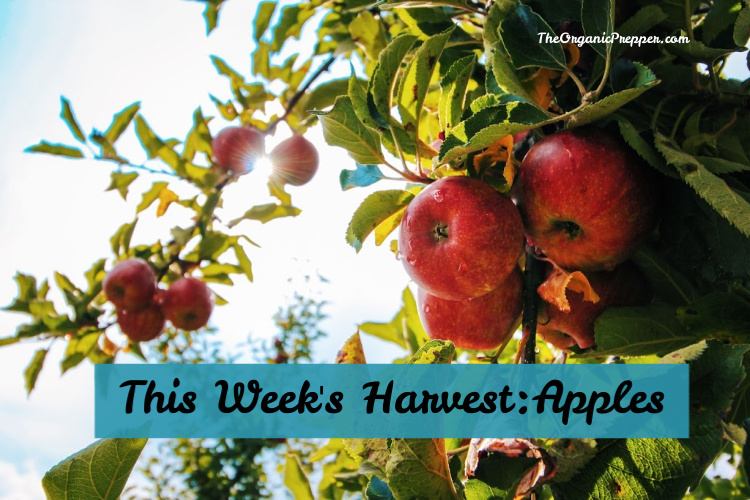
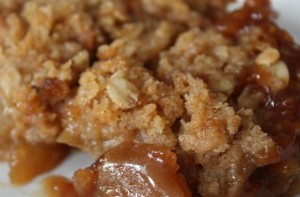
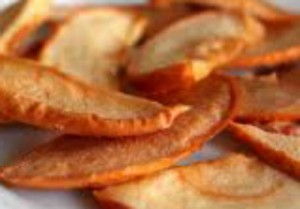
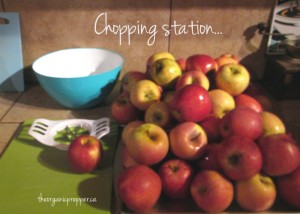
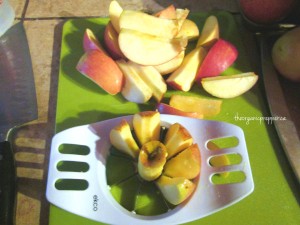
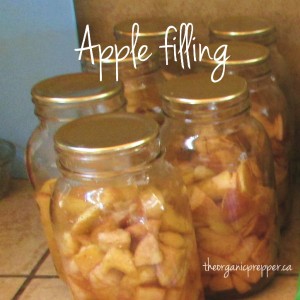
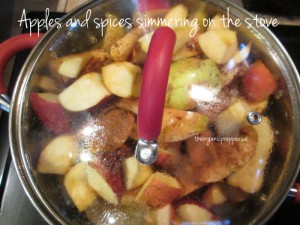
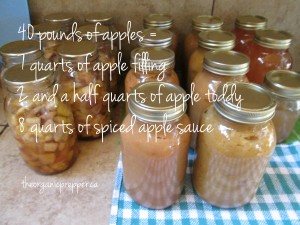











15 Responses
We’ve are currently pressing our apples (and our foraged ones too). We already have 24 bottles of juice and more on the way!
I love the sound of your apple crisp but being in the UK we don’t have sticks of butter. Can you tell me the weight of a stick of butter.
Thanks.
Hi Sue:
I found a convertor that says 1 stick of butter is approximately 113 grams. I know that a 1 pound box of butter contains 4 sticks, if that helps also.
That juice sounds wonderful – enjoy!
Daisy
Fresh picked apples – so good. We have an orchard not too far from home and make it a yearly thing to pick our own. This year because of drought, there weren’t nearly as many, but we managed to get about 35 lbs.
I canned some with a minimal amount of sugar and also made apple pie filling which I also canned. It looks so pretty in the jars!
Saved some for eating and they will keep a really long time. I’m going to try to dry some in my new dehydrator, too.
love your site but there seems to be quite a bit of white sugar in the apple recipies
George:
I generally specify this but looks like I didn’t in this particular article. I use an organic turbinado sugar instead of white sugar when cooking. However lots of people don’t keep that on hand so I try to be more basic in my ingredients. You can certainly cut back on the amount of sugar that you use for these recipes without a major change in your results.
Best wishes ~
Daisy
Hey Daisy, We have several neighbors that have apple trees in their fields, that they do not collect from. My daughter and I spent most of the Saturday picking apples. Hope all is well. Clay
Thanks for the dehydrating ideas.
I have a couple trays on now to try them out.
I skipped the lemon juice.
Is that just to prevent browning?
If they are as good dried as they are after coating them, they won’t last long around here.
There is entirely too much sugar in the apple mixture for the Apple Crisp. If you stop eating wheat you will not crave sugar. The topping has four ingredients: butter (melted to make it easier), oats (part of them can be made into oat flour in the blender), sugar and cinnamon (high quality from Penzeys). Just stir it up and press it onto the sliced apples that have been sprinkled with cinnamon. Apples are in the top 4 of the Dirty Dozen fruits and veggies. You cannot wash a pesticide out of an apple, it is inside from absorbing it when growing.
So when canning the apple chunks you only need 1/4 cup liquid into jar, not totally covering the fruit?
Thank you, thank you, and thank you. I was going to email you and ask for apple recipes like the ones you offered for peaches several weeks ago. Your timing is impeccable. I just finished canning applesauce and came in to see what was going on in the world. Lo and behold here’s the recipes!!! Thank you.
As a home orchardist I have been processing apples for years. Skip the lemon juice unless you want the flavor or you are making an apple salad. It’s just adding an unnecessary ingredient for pie, crumble, sauce, butter, or dried slices.
I mainly make sauce (boiled & smashed apples), butter (reduces sauce w/ cider vinegar), pie kits (peeled and sliced apples w/ brown sugar, cinnamon, salt, & possibly nutmeg or cloves), or dried slices ( cored rings run through the dehydrator). The best apples are saved for fresh eating or storage.
I freeze the pie kits. Sauce and butter can be canned or frozen.
Hi, Daisy!
I’m pretty new to water bath canning but want to try and make apple sauce for my kids, and maybe apple filling—what’s the difference in processing time if I use pint jars instead of quarts? I have a lot of extra quart jars right now. Thank you! I LOVE all the preserving articles you put up—I’m working on as many non-fridge methods as I can this year!
I’m a little late at this but I like to make pineapple applesauce by adding crushed pineapple or add other fruit for different flavors as well as spiced applesauce. Your recipes sound delicious
I have just found your website because I saw your book on amazon so it looks like you would probably know this already but you could use the apple cores and any other part of the apple that is not being used to make apple cider vinegar, YUM! Its really easy as well just put them in a jar top it up with water, a tbsp of sugar and a mother or a small amount of live apple cider vinegar then you will have a mother for future use. Just leave it until its vinegar, save the mother and drain the vinegar off, easy!